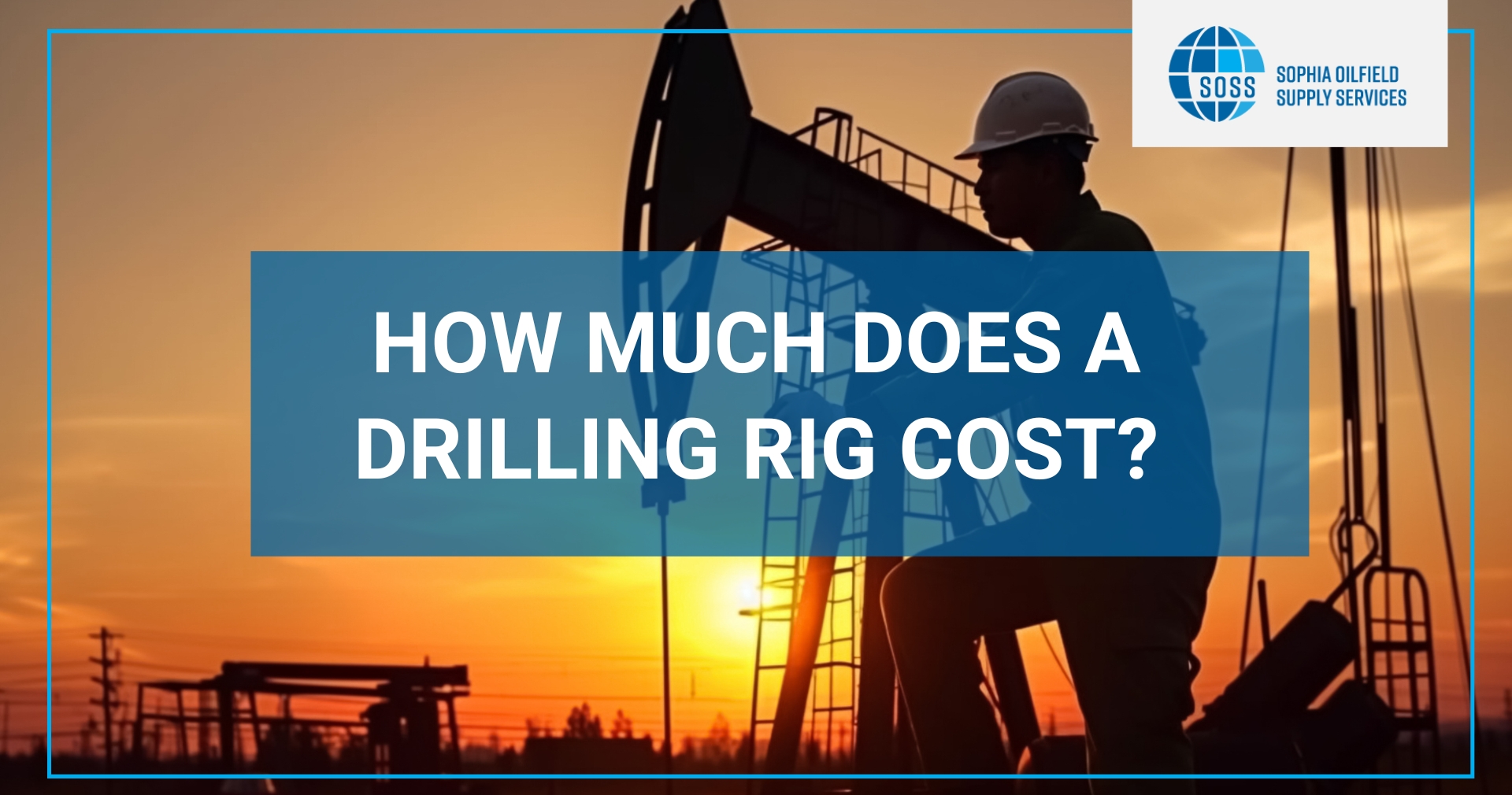Drilling for crude oil and gas is a highly demanding and risky task, and quite costly. Several specialized equipment and components are involved in the drilling process. One such vital piece of machinery is a drilling rig. A drilling rig is a massive structure that holds all the equipment and systems required to drill for oil and gas. But how much does an oil rig cost?
Due to the nature and complexity of drilling, drilling apparatus is quite costly. Drilling rigs are the largest drilling equipment, and it would be apt to say that a newly manufactured rig costs “an arm and a leg”.
Read on as we delve into the price of drilling rigs and the average costs involved in the overall drilling process.
Drilling Rig Function
Drill rigs are mammoth structures used for drilling deep under the Earth’s surface on land and the sea. These rigs serve as a foundation for a drilling operation as they hold all the equipment, machinery, and tools needed for the drilling operation, including the drill bit, drill string, drill pipe, rotary table, mud pumps, and more. Besides this, drill rigs also house the crew involved in the drilling project, whether roustabout or drillers.
Drill rigs use a rotary system that continuously turns the drill string and the drill bit to penetrate the surface, powered by large diesel engine generators. The drilling mud is circulated down the drill string, carrying rock cuttings to the surface while cooling the drill string. The blowout preventers ensure that the flow and pressure of drilling fluid in the wellbore remain stable, mitigating the chances of blowouts that could cause a catastrophic explosion.
A drill rig can either be a fixed platform or a floating rig. Fixed platforms feature concrete legs attached to the ocean floor and are typically used when drilling at lower depths. Floating rigs like semisubmersibles are most suitable for deepwater drilling and positioned using techniques like dynamic positioning.
If you’re curious about the depths these rigs can reach, you can learn more about how deep drilling rigs go and the factors that influence these depths, especially when it comes to deepwater operations.
Oil rigs are large structures that enable drilling deep with complex systems and machinery while also serving as self-sufficient platforms for the drilling crew.
Drilling Rig Cost?
So, how much does a drilling rig cost? The cost of drilling rigs varies depending on a few factors, including but not limited to the type and size of the rig. But that’s not all.
The price of a rig is closely tied to its design and purpose. To better understand the differences between types of drilling rigs and their specific uses, check out this comprehensive guide.
Oil and gas drilling is a lucrative yet expensive venture. Oil rig prices have been somewhat turbulent over the last decade due to the price of oil. Higher oil prices correlate to higher oil production and cost of oil rigs due to greater demand.
For example, the oil demand dwindled significantly by about 20% during the recent COVID-19 pandemic. Therefore, drilling companies had to slash production due to the low demand and prices of oil. That led to a lesser demand for oil rigs, causing a decrease in rig prices. However, as things started to return to normal in the following years, the oil demand gained momentum, leading to greater drilling activity and higher rig prices.
Floating rig day rates have jumped 40% since COVID-19, and as the land rig demand is expected to grow about 14% globally between 2023-2027, we can expect rig daily rates and perhaps the price to increase further.
Drill rigs can either be purchased or acquired on a day-to-day basis on rent. The daily rate varies depending on certain factors like water depth when drilling an offshore oil well and drilling depth.
Land rigs can be acquired at a daily rate of $15,000 to $100,000 per day, depending on the size and horsepower. Basic offshore oil rigs like jack-ups typically start from $200,000 to $ 400,000 per day on average for exploratory wells, whereas the most sophisticated deepwater rigs like drillships could cost around $ 500,000 to 800,000 on a daily basis.
Purchasing an oil rig can be more cost-effective in the long run, and a new land rig costs anywhere from a whopping $10 million to $25 million. An offshore drilling rig is much pricier to own, with prices starting from $500 million. Drillships now cost more than $1 billion to manufacture, so you can expect to pay well over the base amount if you buy these ultra-deepwater vessels.
An offshore oil rig is typically more expensive than an onshore rig due a few main reasons, particularly its complex rig design and cutting-edge technologies.
It is more logistically and environmentally challenging to drill in the sea due to accessibility issues and uncertain wave and wind conditions, specifically when drilling in deep waters. These large structures are more sophisticated and specially engineered to operate effectively and efficiently in hostile environments and at higher depths.
When planning to own an oil rig, it is also crucial to factor in the fuel, maintenance, and repair costs, which could easily exceed $500,000 per year. Offshore rigs have a higher maintenance cost due to the harsh conditions in which they operate.
What Are the Costs Associated With Drilling Rigs?
The enormous cost of buying and operating a drilling rig can be attributed to a few crucial factors, such as its high strength materials, transportation and mobilization expenses, and more.
Specialized Engineering
As mentioned earlier, a rig is specially designed to withstand and operate effectively in extremely harsh and corrosive conditions and at high depths and pressures, particularly when drilling offshore.
Oil rigs are gigantic structures and engineering marvels that can take two to five years to construct due to their complexity and colossal size before being transported to the drilling site.
After meticulous planning, a detailed 3D computer-aided design of the type of rig is created mimicking the rough onsite environmental conditions that it must counter, such as high winds and waves.
Then, the rig structure is created by welding high-strength alloy steel before its vital components and systems are installed. Offshore rigs are then anchored to the sea bed with steel or concrete legs supporting it or remain afloat above the water using dynamic positioning.
Complex Technologies
Drill rigs are equipped with several key advanced equipment and machinery that enable the extraction of oil and gas from the earth’s crust. The major systems and components of a drill rig include:
The Hoisting System
It features the derrick or mast which lifts or lowers the drill string.
The Rotary System
It could be a rotary table or top drive, which rotates the drill bit to dig into the surface.
The Circulating System
It consists of the mud pump and mud tank that circulate the drilling mud through the drill string and cool it down.
The Blowout Prevention System
Components like the annular preventers and accumulators help prevent the abnormal flow of drilling fluids which could cause a blowout.
The Power System
Components like generators or electric motors provide power to the drill rig systems.
Labor and Operational Costs
Building and operating a drilling rig requires the expertise of a large number of highly skilled personnel who must ensure the rig’s precise and safe construction and operation day and night.
Depending on the rig type, the cost of constructing and operating the rig could vary. However, the operational costs of offshore rigs are always much more costly than land rigs due to the complexities and challenges of drilling in the sea.
From derrickhands to drillers, offshore crews undergo extensive training and possess better skills and knowledge, which translates to higher salaries. They must also reside on the platform in their living quarters when drilling in remote areas and be transported to the drilling site, often through helicopters, all of which increase the labor costs.
Site Accessibility
Accessing certain drilling sites with trucks and trailers carrying heavy loads can be virtually impossible without the presence of good infrastructure. A drill rig must be moved to the wellbore location. That requires the presence of suitable roads that would support a tremendous load of transporting these megastructures, adding to the cost of installing the rig.
Rig Assembly
After being transported to the rig site in different parts on trucks, the components are then assembled and carefully positioned onto the oil rig using heavy equipment like cranes, which are a significant cost of drilling.
Even after a rig is assembled and operational, it’s essential to maintain it over time. Understanding what workover rigs are can be key for ongoing well maintenance. These rigs are specifically designed to help with repairs, ensuring the well stays productive for years.
About Sophia Oilfield Supply Services
Sophia Oilfield Supply Services is a premier provider of oilfield products and equipment for more than 30 years. Our rigs are manufactured in accordance with the best industry standards and regulatory guidelines using cutting-edge technology, ensuring unhindered performance and longevity in the most challenging drilling environments.
Needless to say, a drilling rig is a huge investment requiring careful forethought. Whether it is onshore or offshore drilling, we are here to help you with the appropriate drilling equipment that suits your unique project requirements.
Explore our inventory of new and used drilling rigs for sale and call us today for a personalized estimate for our advanced drilling rigs.

